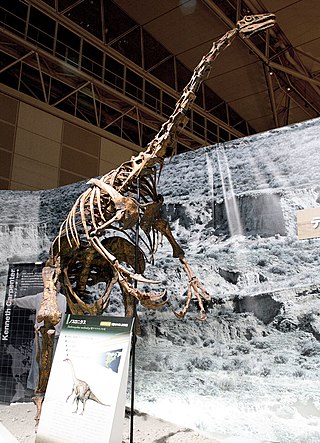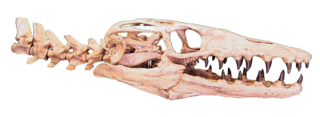
Nothronychus is a genus of therizinosaurid theropod dinosaurs that lived in North America during the Late Cretaceous period. The type species, Nothronychus mckinleyi, was described by James Kirkland and Douglas G. Wolfe in 2001. It was recovered near New Mexico's border with Arizona, in an area known as the Zuni Basin, from rocks assigned to the Moreno Hill Formation, dating to the late Cretaceous period, around 92 million years ago. A second specimen, described in 2009 as a second species, Nothronychus graffami, was found in the Tropic Shale of Utah, dating to the early Turonian, between one million and a half million years older than N. mckinleyi.

Selmasaurus is an extinct genus of marine lizard belonging to the mosasaur family. It is classified as part of the Plioplatecarpinae subfamily alongside genera like Angolasaurus and Platecarpus. Two species are known, S. russelli and S. johnsoni; both are exclusively known from Santonian deposits in the United States.

Hagryphus is a monospecific genus of caenagnathid dinosaur from southern Utah that lived during the Late Cretaceous in what is now the Kaiparowits Formation of the Grand Staircase–Escalante National Monument. The type and only species, Hagryphus giganteus, is known only from an incomplete but articulated left manus and the distal portion of the left radius. It was named in 2005 by Lindsay E. Zanno and Scott D. Sampson. Hagryphus has an estimated length of 2.4–3 metres and weight of 50 kilograms.

The Halisaurinae are a subfamily of mosasaurs, a group of Late Cretaceous marine lizards. They were small to medium-sized, ranging from just under 3 meters in Eonatator sternbergi to as much as 8 or 9 meters in Pluridens serpentis. They tended to have relatively slender jaws and small, numerous teeth, suggesting a diet of small fish and other prey. Although the skeleton is primitive compared to other Mosasauridae in many respects, halisaurines had the distinctive hypocercal tail of other mosasaurids suggesting good swimming ability, and they persisted alongside other mosasaurs until the end of the Cretaceous. The earliest known remains of halisaurines occur in rocks of Santonian age and the subfamily persists until the latest Maastrichtian. Halisaurines are known from North and South America, Europe, Asia and Africa, indicating a more or less global distribution in the Late Cretaceous. Four genera are currently recognized: Eonatator, Halisaurus, Phosphorosaurus and Pluridens.

Russellosaurus is an extinct genus of tethysaurine mosasauroid from the Late Cretaceous of North America. The genus was described from a skull discovered in an exposure of the Arcadia Park Shale at Cedar Hill, Dallas County in the south-central part of the DFW Metroplex in Texas, United States. The skull was found in 1992 by a member of the Dallas Paleontological Society, who then donated to the museum. Other fragmentary specimens of Russelosaurus have been recovered from the slightly older Kamp Ranch Limestone at two other localities in the Dallas area.
Platecarpus is an extinct genus of aquatic lizards belonging to the mosasaur family, living around 84–81 million years ago during the middle Santonian to early Campanian, of the Late Cretaceous period. Fossils have been found in the United States and possible specimens in Belgium and Africa. A well-preserved specimen of Platecarpus shows that it fed on moderate-sized fish, and it has been hypothesized to have fed on squid, and ammonites as well. Like other mosasaurs, it was initially thought to have swum in an eel-like fashion, although another study suggests that it swam more like modern sharks. An exceptionally well-preserved specimen of P. tympaniticus known as LACM 128319 shows skin impressions, pigments around the nostrils, bronchial tubes, and the presence of a high-profile tail fluke, showing that it and other mosasaurs did not necessarily have an eel-like swimming method, but were more powerful, fast swimmers. It is held in the Natural History Museum of Los Angeles County. Isotopic analysis on teeth specimens has suggested that this genus and Clidastes may have entered freshwater occasionally, just like modern sea snakes.

Dolichorhynchops is an extinct genus of polycotylid plesiosaur from the Late Cretaceous of North America, containing three species, D. osborni, D. bonneri and D. tropicensis, as well as a questionably referred fourth species, D. herschelensis. Dolichorhynchops was a prehistoric marine reptile, but at least one species, D. tropicensis, likely entered rivers to collect gastroliths. Its Greek generic name means "long-nosed face". While typically measuring about 3 metres (9.8 ft) in length, the largest specimens of D. osborni and D. bonneri are estimated to have a total body length more than approximately 4.29 metres (14.1 ft) and 5.09 metres (16.7 ft), respectively.

Edgarosaurus is a genus of polycotylid plesiosaur from the Thermopolis Shale, containing one species, E. muddi. The type specimen was found in Early Cretaceous rocks in the state of Montana in the United States. At the time, this location was covered by part of the Western Interior Seaway. Edgarosaurus was one of the first polycotylids that evolved to become native to the Western Interior Seaway.

The Dakota is a sedimentary geologic unit name of formation and group rank in Midwestern North America. The Dakota units are generally composed of sandstones, mudstones, clays, and shales deposited in the Mid-Cretaceous opening of the Western Interior Seaway. The usage of the name Dakota for this particular Albian-Cenomanian strata is exceptionally widespread; from British Columbia and Alberta to Montana and Wisconsin to Colorado and Kansas to Utah and Arizona. It is famous for producing massive colorful rock formations in the Rocky Mountains and the Great Plains of the United States, and for preserving both dinosaur footprints and early deciduous tree leaves.

Angolasaurus is an extinct genus of mosasaur. Definite remains from this genus have been recovered from the Turonian and Coniacian of Angola, and possibly the Coniacian of the United States, the Turonian of Brazil, and the Maastrichtian of Niger. While at one point considered a species of Platecarpus, recent phylogenetic analyses have placed it between the (then) plioplatecarpines Ectenosaurus and Selmasaurus, maintaining a basal position within the plioplatecarpinae.

The Tropic Shale is a Mesozoic geologic formation. Dinosaur remains are among the fossils that have been recovered from the formation, including Nothronychus graffami. The Tropic Shale is a stratigraphic unit of the Kaiparowits Plateau of south central Utah. The Tropic Shale was first named in 1931 after the town of Tropic where the Type section is located. The Tropic Shale outcrops in Kane and Garfield counties, with large sections of exposure found in the Grand Staircase–Escalante National Monument.

The Straight Cliffs Formation is a stratigraphic unit in the Kaiparowits Plateau of south central Utah. It is Late Cretaceous in age and contains fluvial, paralic, and marginal marine (shoreline) siliciclastic strata. It is well exposed around the margin of the Kaiparowits Plateau in the Grand Staircase – Escalante National Monument in south central Utah. The formation is named after the Straight Cliffs, a long band of cliffs creating the topographic feature Fiftymile Mountain.

Cardabiodon is an extinct genus of large mackerel shark that lived about 95 to 91 million years ago (Ma) during the Cenomanian to Turonian of the Late Cretaceous. It is a member of the Cardabiodontidae, a family unique among mackerel sharks due to differing dental structures, and contains the two species C. ricki and C. venator. Cardabiodon fossils have been found in Australia, North America, England, and Kazakhstan. It was likely an antitropical shark that inhabited temperate neritic and offshore oceans between 40° and 60° paleolatitude, similar to the modern porbeagle shark.

Teratophoneus is a genus of tyrannosaurine theropod dinosaur that lived during the late Campanian age of the Late Cretaceous period, in what is now Utah. It contains a single known species, T. curriei. It is known from an incomplete skull and postcranial skeleton recovered from the Kaiparowits Formation and was specifically named T. curriei in honor of famed paleontologist Philip J. Currie.

Latoplatecarpus is an extinct genus of plioplatecarpine mosasaur known from the Late Cretaceous of the northern Gulf of Mexico and the Western Interior Basin of North America. It was among the largest plioplatecarpine mosasaur, with L. nichollsae measuring over 8 metres (26 ft) in total body length.
Talos is an extinct genus of carnivorous bird-like theropod dinosaur, an advanced troodontid which lived during the late Cretaceous period in the geographic area that is now Utah, United States.

Megacephalosaurus is an extinct genus of short-necked pliosaur that inhabited the Western Interior Seaway of North America about 94 to 93 million years ago during the Turonian stage of the Late Cretaceous, containing the single species M. eulerti. It is named after its large head, which is the largest of any plesiosaur in the continent and measures up to 1.75 meters (5.7 ft) in length. Megacephalosaurus was one of the largest marine reptiles of its time with an estimated length of 6–9 meters (20–30 ft). Its long snout and consistently sized teeth suggest that it preferred a diet on smaller-sized prey.

Adelolophus is a genus of lambeosaurine dinosaur from Upper Cretaceous rocks in the U.S. state of Utah. The type and only known species is A. hutchisoni; the type specimen consists only of a broken maxilla. It constitutes the oldest known lambeosaur remains from North America, as well as the only known lambeosaur species from the Wahweap Formation, of which it pertains to the Upper Member. Among its relatives, it seems to be particularly similar to Parasaurolophus, rather than animals like Lambeosaurus; phylogenetic analysis confirms this, finding it in Parasaurolophini. It would have lived in a wet environment, bordering on the sea but with a more arid season during some times of the year. This environment would have been shared with a diverse variety of fish and turtles, as well as other dinosaurs like ceratopsids and tyrannosaurids.
















